
Mary Ann "Polly" Nichols was the first canonical victim of the unidentified serial killer known as Jack the Ripper, who is believed to have murdered and mutilated at least five women in the Whitechapel and Spitalfields districts of London from late August to early November 1888.
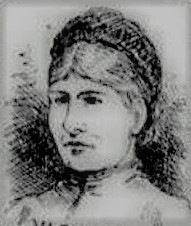
Emma Elizabeth Smith was a prostitute and murder victim of mysterious origins in late-19th century London. Her killing was the first of the Whitechapel murders, and it is possible she was a victim of the serial killer known as Jack the Ripper, though this is considered unlikely by most modern authors.
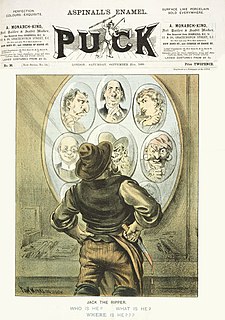
A series of murders that took place in the East End of London from August to November 1888 was blamed on an unidentified assailant who was nicknamed Jack the Ripper. Since that time, the identity of the killer or killers has been widely debated, and over 100 Jack the Ripper suspects have been named. Though many theories have been advanced, experts find none widely persuasive, and some are hardly taken seriously at all. Due to the extensive time interval since the murders, the killer will likely never be identified despite ongoing speculation as to his identity.
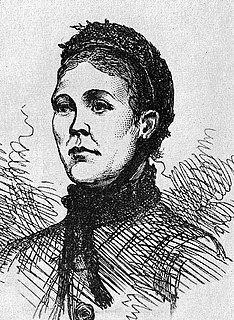
Catherine Eddowes is the fourth of the canonical five victims of the notorious unidentified serial killer known as Jack the Ripper, who is believed to have killed and mutilated a minimum of five women in the Whitechapel and Spitalfields districts of London from late August to early November 1888.
Aaron Kosminski was a Polish barber and hairdresser, and suspect in the Jack the Ripper case.

Sir Melville Leslie Macnaghten was Assistant Commissioner (Crime) of the London Metropolitan Police from 1903 to 1913. A highly regarded and famously affable figure of the late Victorian and Edwardian eras he played major investigative roles in cases that led to the establishment and acceptance of fingerprint identification. He was also a major player in the pursuit and capture of Dr. Crippen, and of the exoneration of a wrongly convicted man, Adolph Beck, which helped lead to the creation of the Court of Criminal Appeal in 1907.

Jack the Ripper was an unidentified serial killer active in the largely impoverished areas in and around the Whitechapel district of London in 1888. In both the criminal case files and contemporary journalistic accounts, the killer was called the Whitechapel Murderer and Leather Apron.
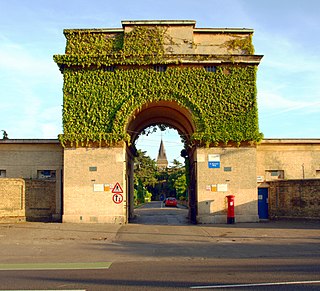
St Bernard's Hospital, also known as Hanwell Insane Asylum and the Hanwell Pauper and Lunatic Asylum, was an asylum built for the pauper insane, opening as the First Middlesex County Asylum in 1831. Some of the original buildings are now part of the headquarters for the West London Mental Health NHS Trust (WLMHT).
The Metropolitan Asylums Board (MAB) was established under Poor Law legislation to deal with London's sick and poor. It was established by the Metropolitan Poor Act 1867 and dissolved in 1930, when its functions were transferred to the London County Council.
The Commissioners in Lunacy or Lunacy Commission were a public body established by the Lunacy Act 1845 to oversee asylums and the welfare of mentally ill people in England and Wales. It succeeded the Metropolitan Commissioners in Lunacy.

St Pancras Hospital is part of the Camden and Islington NHS Foundation Trust in the St Pancras / Somers Town area of central London, near Camden Town. The hospital specialises in geriatric and psychiatric medicine.

Chief Inspector Donald Sutherland Swanson was born at Geise, where his father operated a distillery, before the family moved in 1851 to Thurso, and was a senior police officer in the Metropolitan Police in London during the notorious Jack the Ripper murders of 1888.

The Cleveland Street Workhouse is a Georgian property in Cleveland Street, Marylebone, built between 1775 and 1778 for the care of the sick and poor of the parish of St Paul Covent Garden under the Old Poor Law. From 1836, it became the workhouse of the Strand Union of parishes. The building remained in operation until 2005 after witnessing the complex evolution of the healthcare system in England. After functioning as a workhouse, the building became a workhouse infirmary before being acquired by the Middlesex Hospital and finally falling under the NHS. In the last century it was known as the Middlesex Hospital Annexe and the Outpatient Department. It closed to the public in 2005 and it has since been vacated. On 14 March 2011 the entire building became Grade II Listed. Development of the site began in 2019 by current owner University College London Hospitals (UCLH) Charity as a mixed-use development including residential, commercial and open space, but construction has been held up by the necessity to remove human remains stemming from the use of the area around the workhouse as a parish burial ground between 1780 and 1853. There has also been controversy about the amount of social housing to be included in the development.
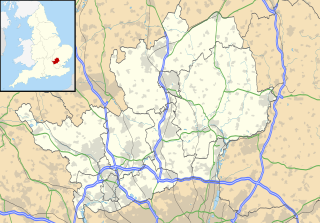
Leavesden is a residential and commercial area in Hertfordshire, England, contiguous with the northern suburbs of Watford. It lies within the M25 Motorway. On its eastern side it is bounded by the M1 Motorway. Leavesden is part of Abbots Langley civil parish and is also the name of a district council ward in Three Rivers District. Leavesden Green is an adjoining residential community which lies partly in Three Rivers and partly in the Borough of Watford.

Rainhill Hospital was a very large psychiatric hospital complex that was located in Rainhill, formerly Lancashire but now Merseyside, England.

Highgate Hospital was a name used to refer to the infirmary building which opened in 1869 on the St Pancras side of Dartmouth Park Hill in Highgate, London.
Mental health in the United Kingdom involves state, private and community sector intervention in mental health issues. One of the first countries to build asylums, the United Kingdom was also one of the first countries to turn away from them as the primary mode of treatment for the mentally ill. The 1960s onwards saw a shift towards Care in the Community, the British version of deinstitutionalisation. The majority of mental health care is now provided by the National Health Service, assisted by the private and the voluntary sectors.
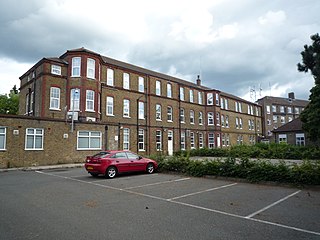
St Lawrence's Hospital was a mental health facility in Caterham, Surrey.
Leavesden Hospital Football Club was a football club based in Leavesden, England.
Sir William Henry Wyatt (1823-1898) was Magistrate and Deputy Lieutenant for Middlesex, and social reformer in his role of Chairman of both the Middlesex County Lunatic Asylum at Colney Hatch and the Metropolitan Asylum for Chronic Imbeciles at Leavesden, Hertfordshire.

















